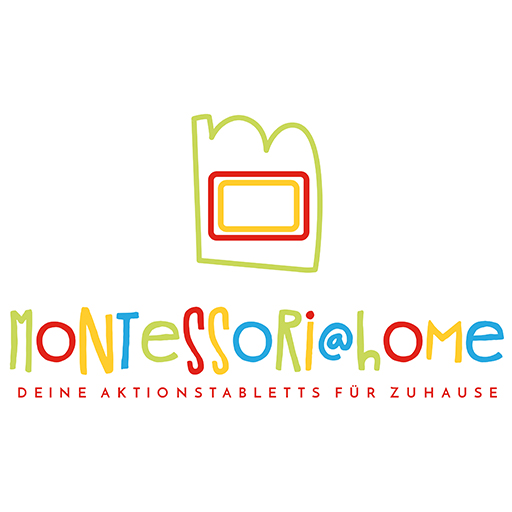Male back
Objective: Promote color perception
Material: Galt pop-up toy*
Preparation: Put the sticks in the basket and place it on the left side of the tray. Place the wooden block on the right side of the tray.
Execution: The child takes the wooden sticks and puts them into the holes. Make sure that they are assigned to the appropriate colored hole. Afterwards, all the sticks are put back into the basket.
This not only promotes color perception but also refines the child’s motor skills.
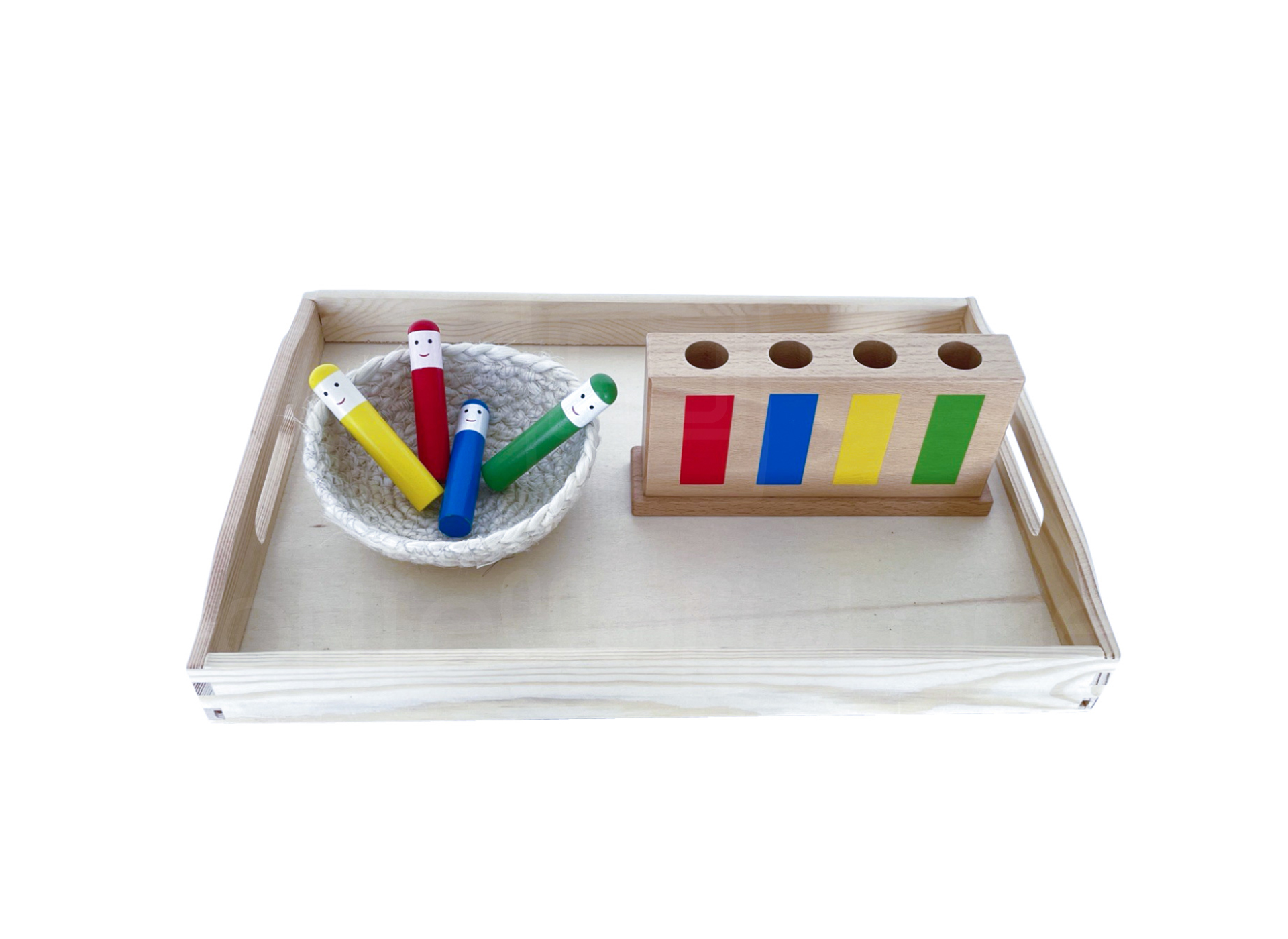
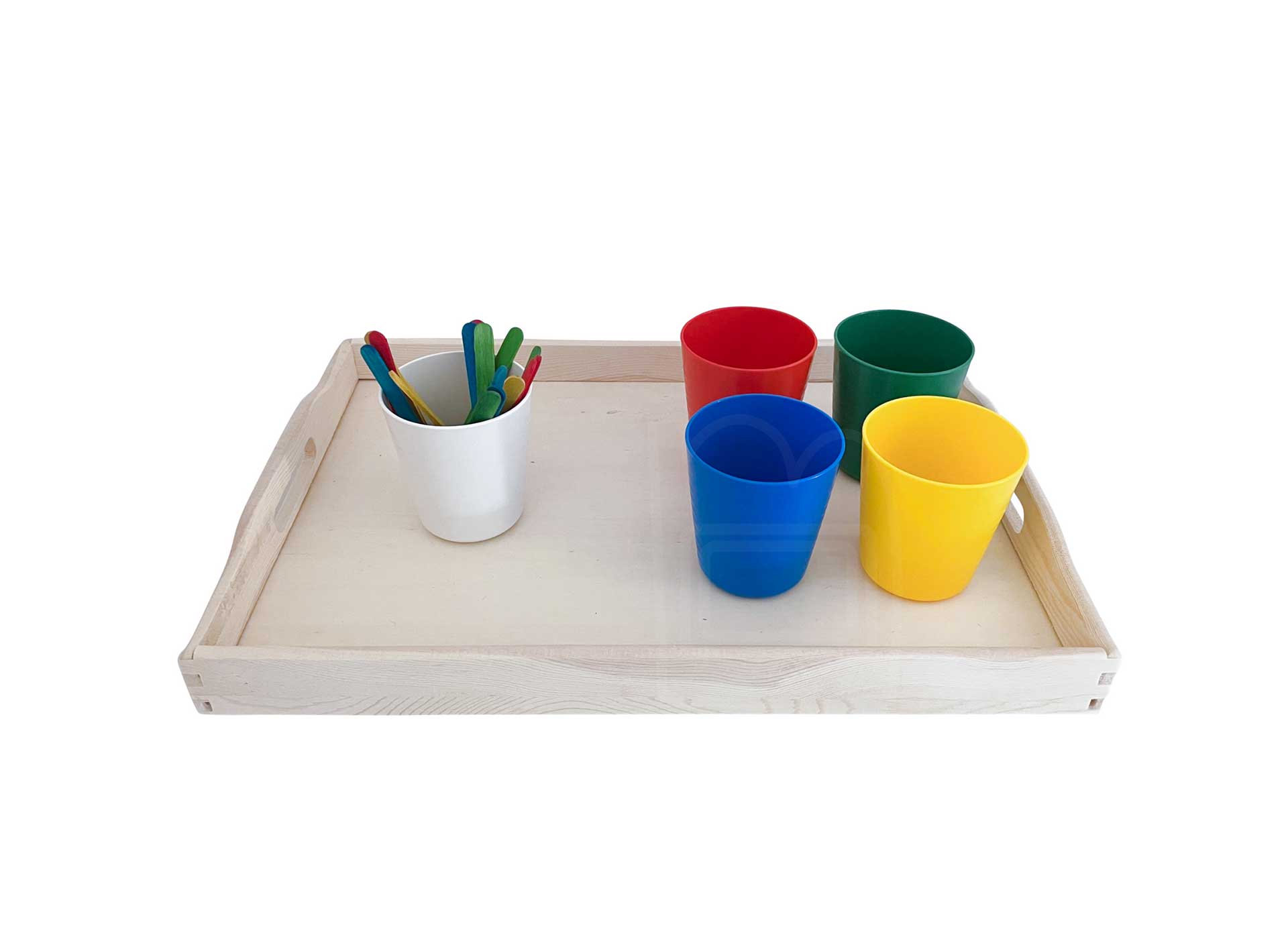
Sort wooden handles
Objective: Promote eye-hand coordination and color perception
Material: colorful popsicle sticks*, colorful plastic cups
Preparation: A handful of colorful wooden popsicle sticks are placed in the white cup and it is placed on the left side of the tray. On the right side of the tray 4 colored cups are placed.
Execution: The child takes a wooden stick from the white cup and puts it into the matching colored cup on the right side. This is repeated until the white cup is empty. Then all the stems go back into the white cup and are mixed together.
Bead order
Objective: Promote eye-hand coordination and color perception
Material: colored wooden beads*, colored paper, glue, scissors, small boxes, basket
Preparation: 6 boxes of the same size are glued together. Then cut out 6 square pieces of paper in the colors of the beads and glue them into the boxes. Then 6 large beads, one for each color, are placed in a small basket. This is placed on the tray on the left, with the made shape on the right.
Execution: The child puts the beads into the boxes. In each case, the color matching bead into one of the 6 shapes. Then the beads are put back into the basket.
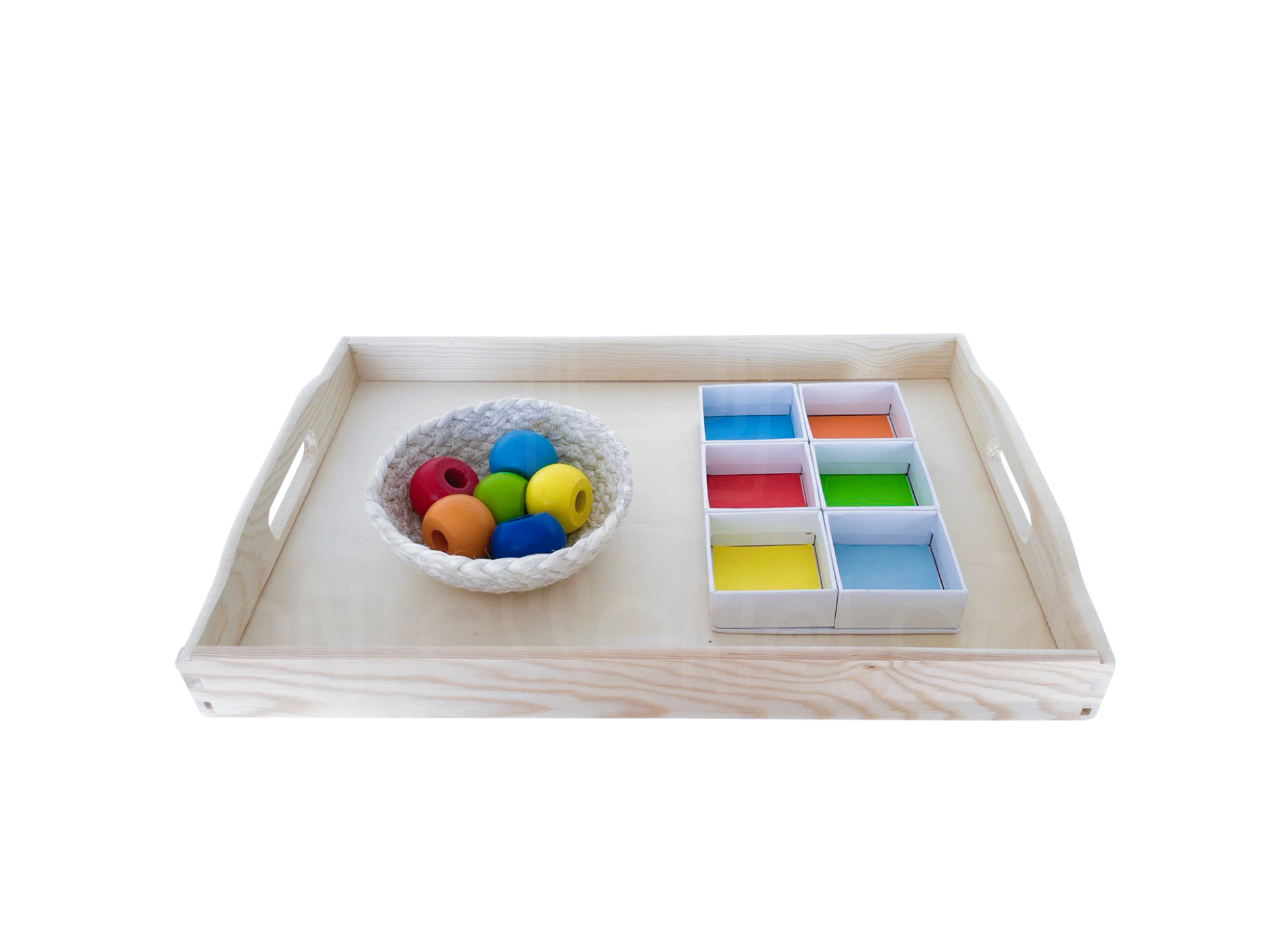
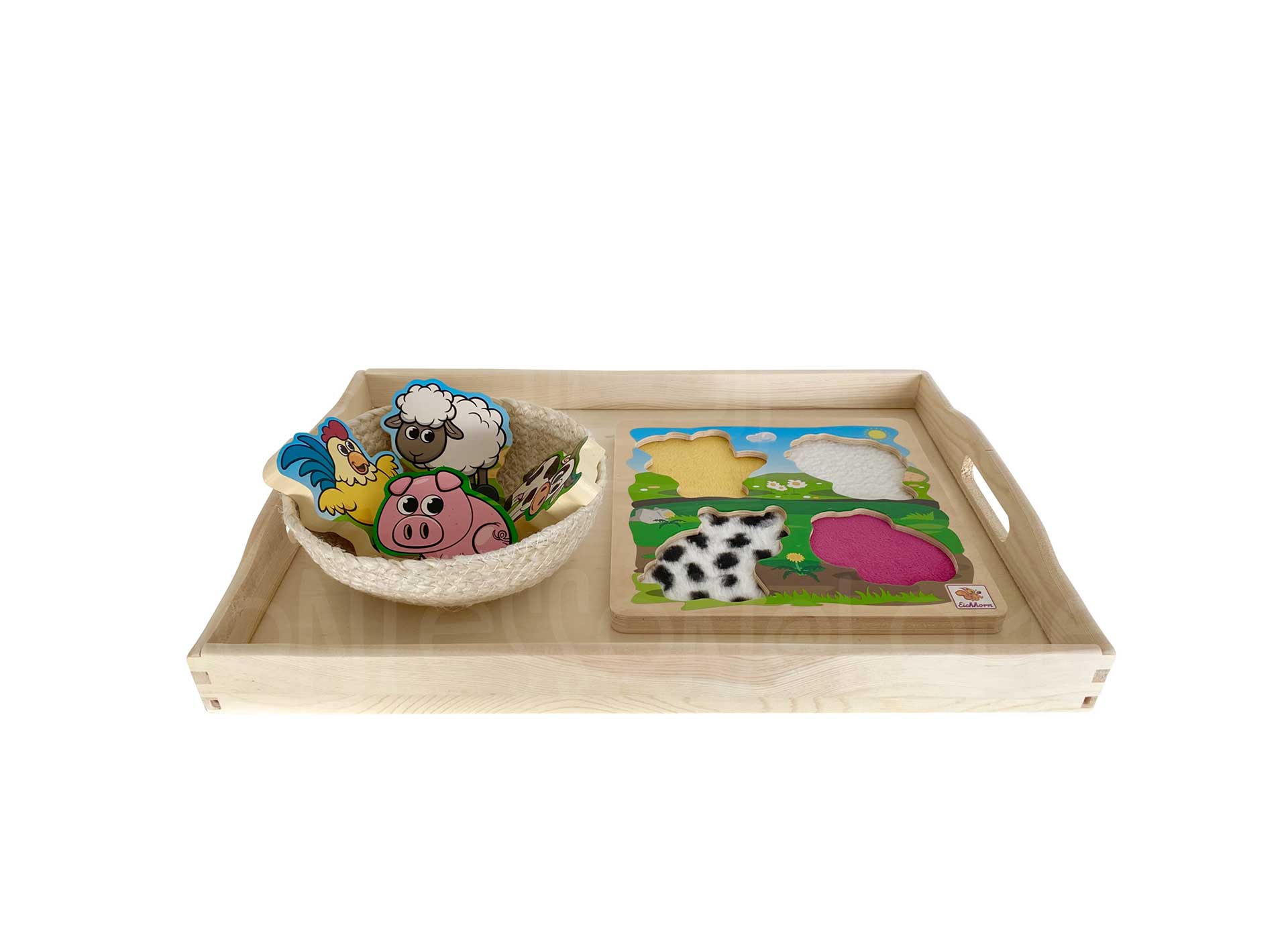
Large touch puzzle
Objective: Promote eye-hand coordination, sense of touch and visual perception
Material: Feeling puzzle from Eichhorn*
Preparation: The puzzle pieces of the feeling puzzle are placed in the basket. The basket is placed on the left side of the tray, the frame on the right side of the tray.
Execution: The child places the puzzle pieces without a handle back into the frame. The color and the surface material of the frame serve as additional support.
Sorting box
Objective: Promote eye-hand coordination and shape perception
Material: Sorting box*, basket, shapes
Preparation: The shapes are taken out of the sorting box and placed in the basket. The basket is placed on the left side of the tray, the sorting box on the right side.
Execution: The child throws the shapes through the corresponding hole into the box. When all the shapes are in the box, they are put back into the basket.
This work promotes not only shape perception but also the child’s motor skills.
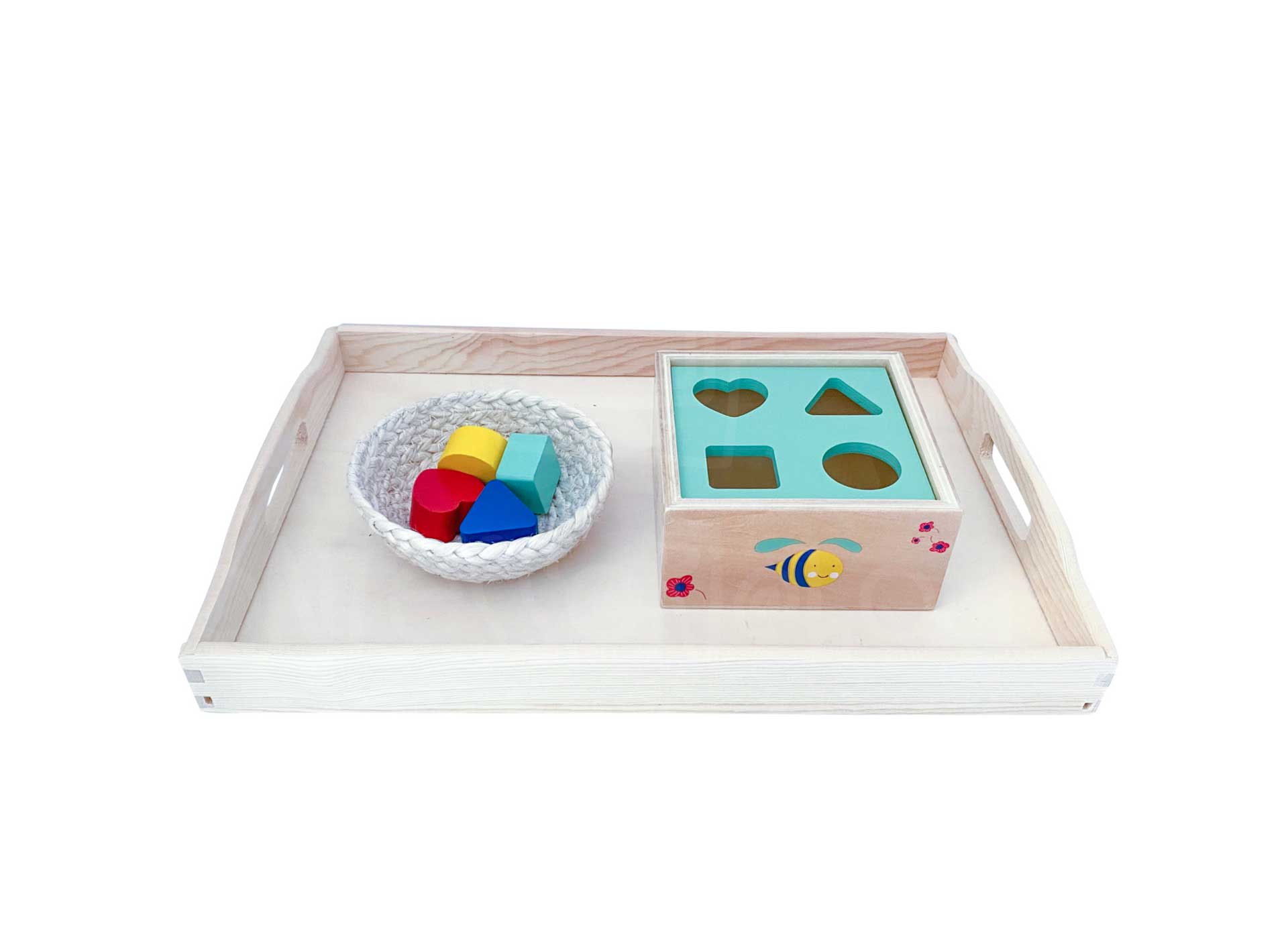
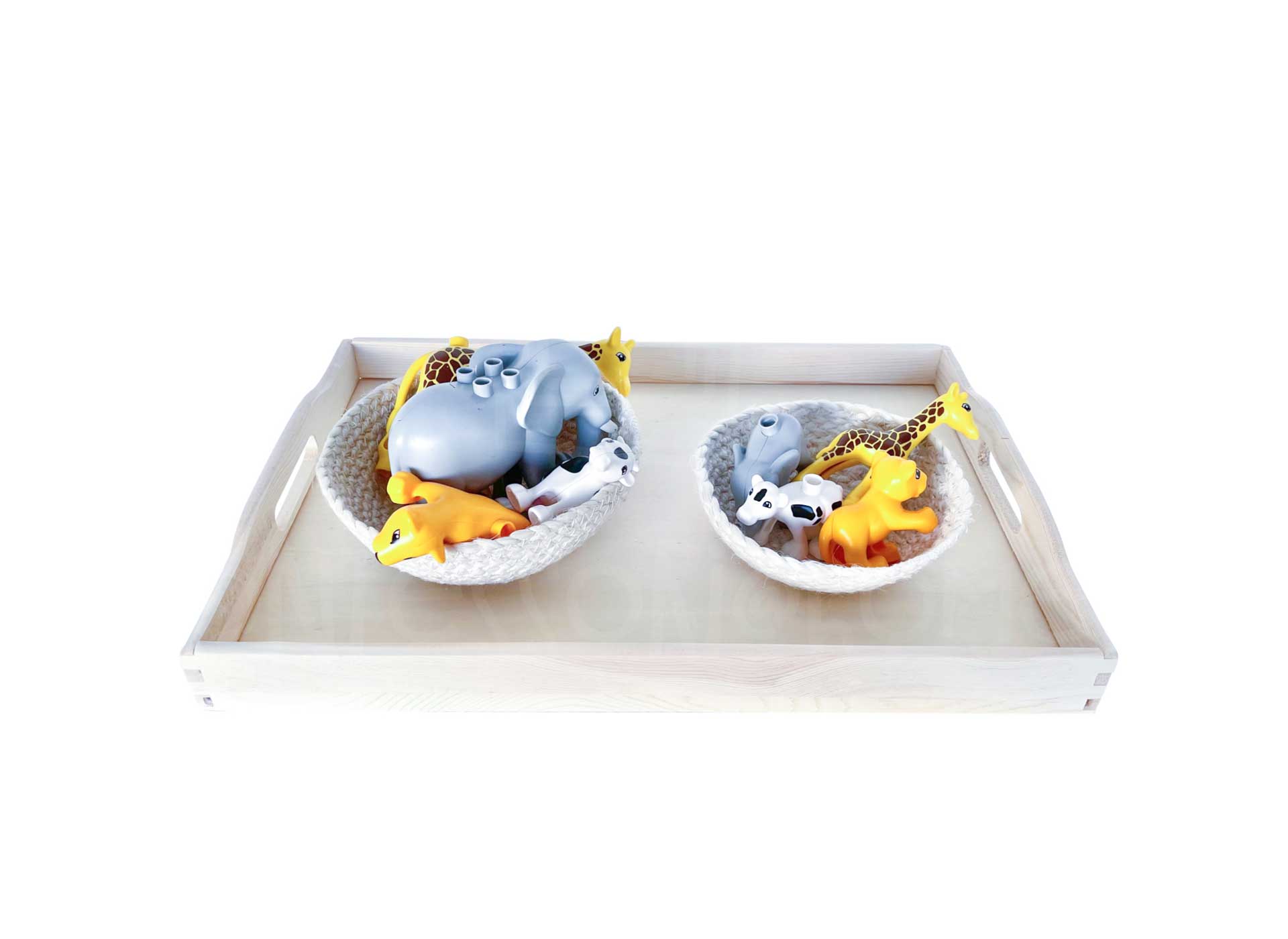
Find the baby
Objective: Promote visual perception
Material: Duplo animals
Preparation: The animals are sorted into large and small animals. The big ones go in the left and the small animals in the right basket. Then both baskets are placed on a tray.
Execution: The child sorts the large animal from the left basket and the small animal from the right basket together. So that all the babies are with their parents afterwards. Older children can also name the animals and make the appropriate sounds. Then the animals are sorted back into their baskets.
Puzzle copy laying
Objective: Promote eye-hand coordination and shape perception
Material: Large puzzle pieces “Can you match it”*, basket, copier, printer
Preparation: 4 puzzles are selected from the puzzle set. These are placed on a color copier and copied. Then the puzzle pieces are disassembled and placed in the basket. This is placed on the tray to the left, and the finished copy from the printer is placed to the right.
Execution: The child takes the puzzle pieces out of the basket and places them on the right side of the finished copy. This gives the child a simple introduction to puzzling equally sized loose puzzle pieces. When all 4 puzzles are finished, they are disassembled and placed back in the basket.
This tray promotes not only the shape perception but also the motor skills of the child.
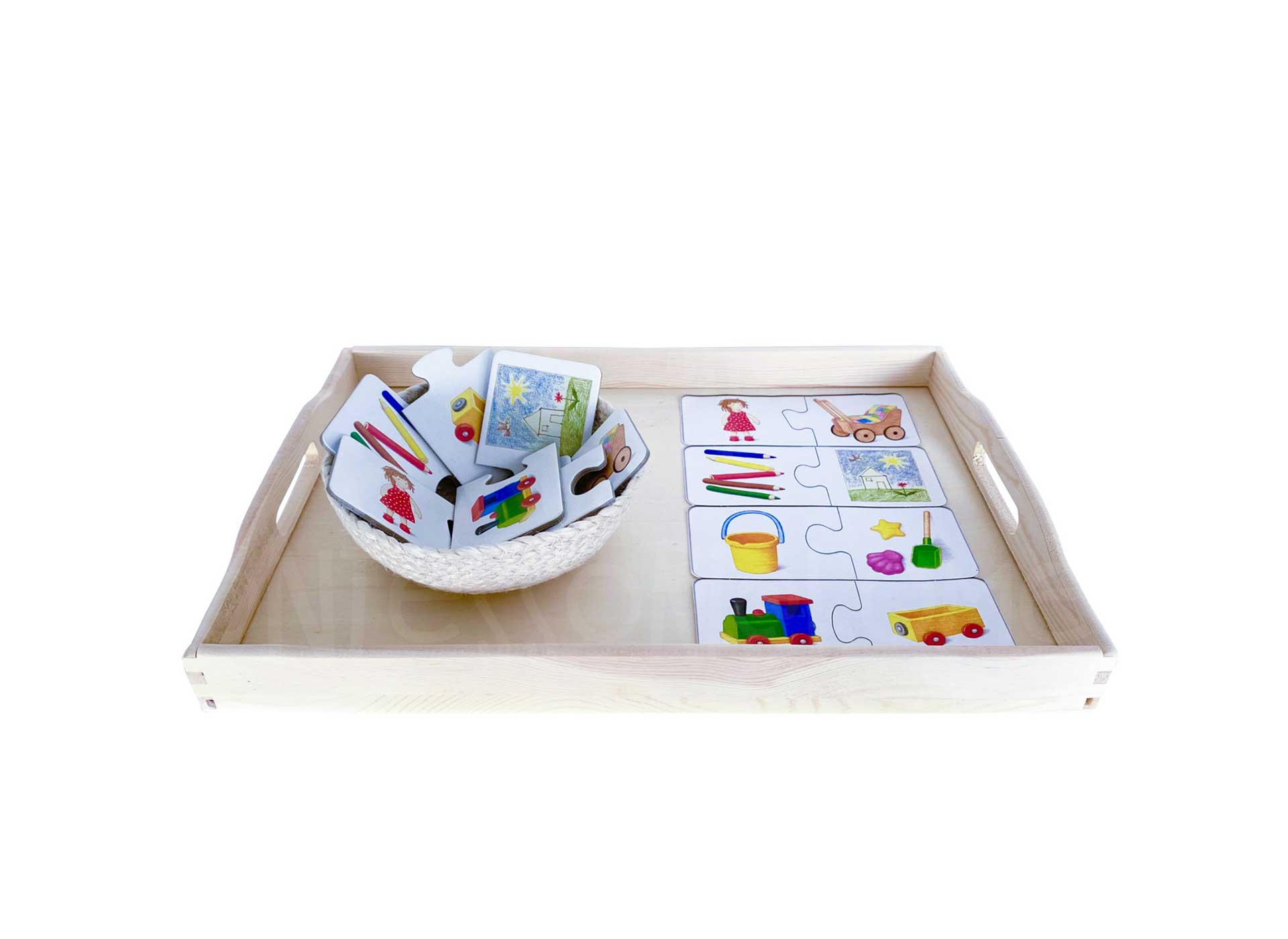
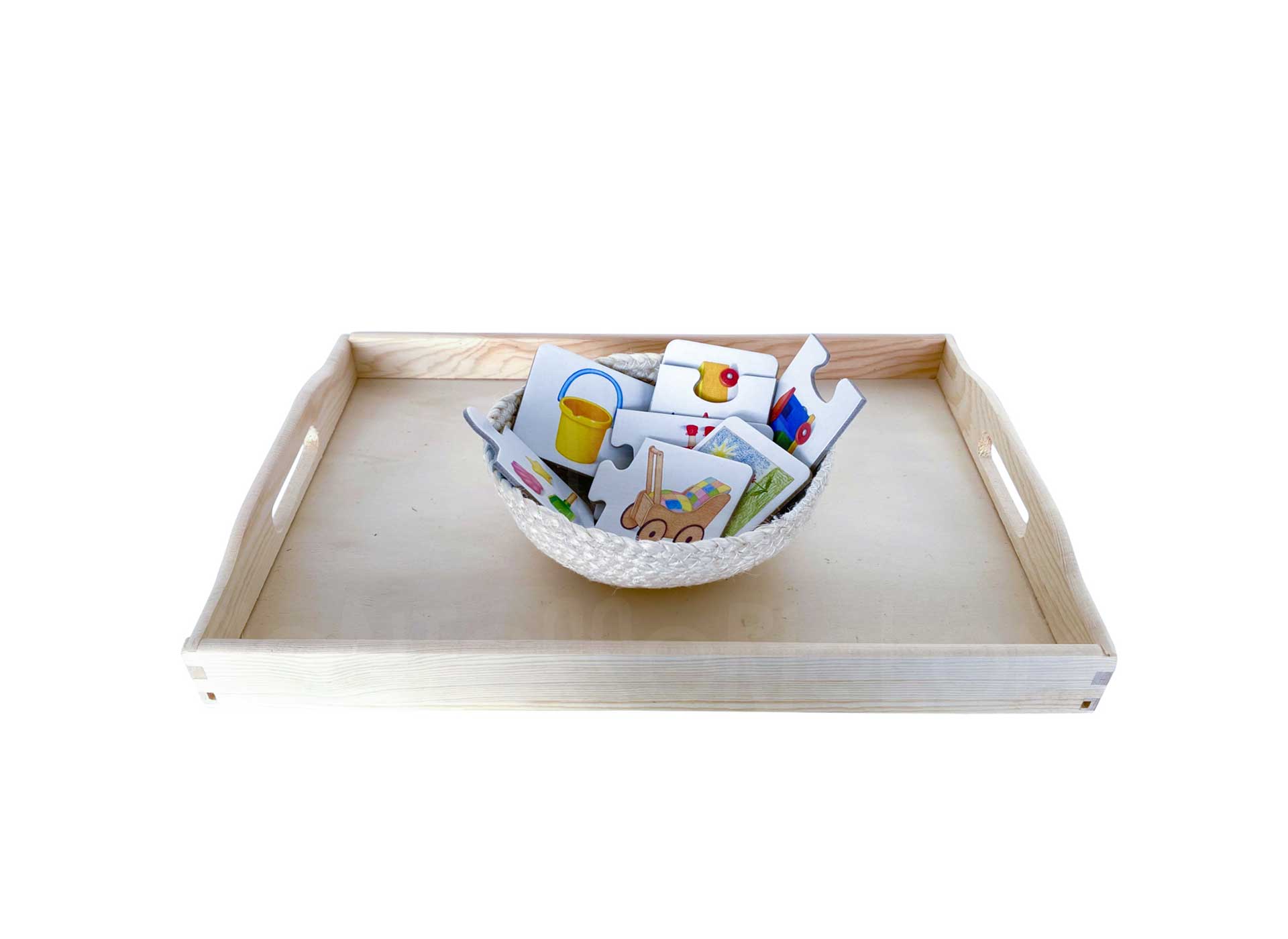
First 2 pieces puzzle
Objective: Promote visual perception, language comprehension and motor skills
Material: Puzzle pieces*, basket
Preparation: The puzzle pieces are placed in the basket and the basket is placed on the tray.
Execution: The child tries to place the puzzle pieces, which he/she put on the copy on the previous tray, without the help of the copy. This is also helped by the matching pictures, which promote language comprehension. Older children name the objects as they put them together. If this is mastered, the child can also be asked to explain why the two pieces fit together. Afterwards, the puzzle pieces are returned to the basket.
This material not only promotes visual perception and motor skills, but also language comprehension.
Stacking shapes
Objective: Promote shape perception
Material: Eichhorn stacking board*, basket
Preparation: The shapes of one color are each placed individually on a stick. The shapes of the three remaining colors are placed in the basket. The basket is placed on the left side of the tray, the stacking board on the right.
Execution: The child sorts the matching shapes from the left basket onto the stacking board. Older children can sort color by color so that afterwards the shapes are placed on all the sticks in the same color order. Then all the shapes except the original one (blue in this case) are put back into the basket.
This material can also be used to promote motor skills.
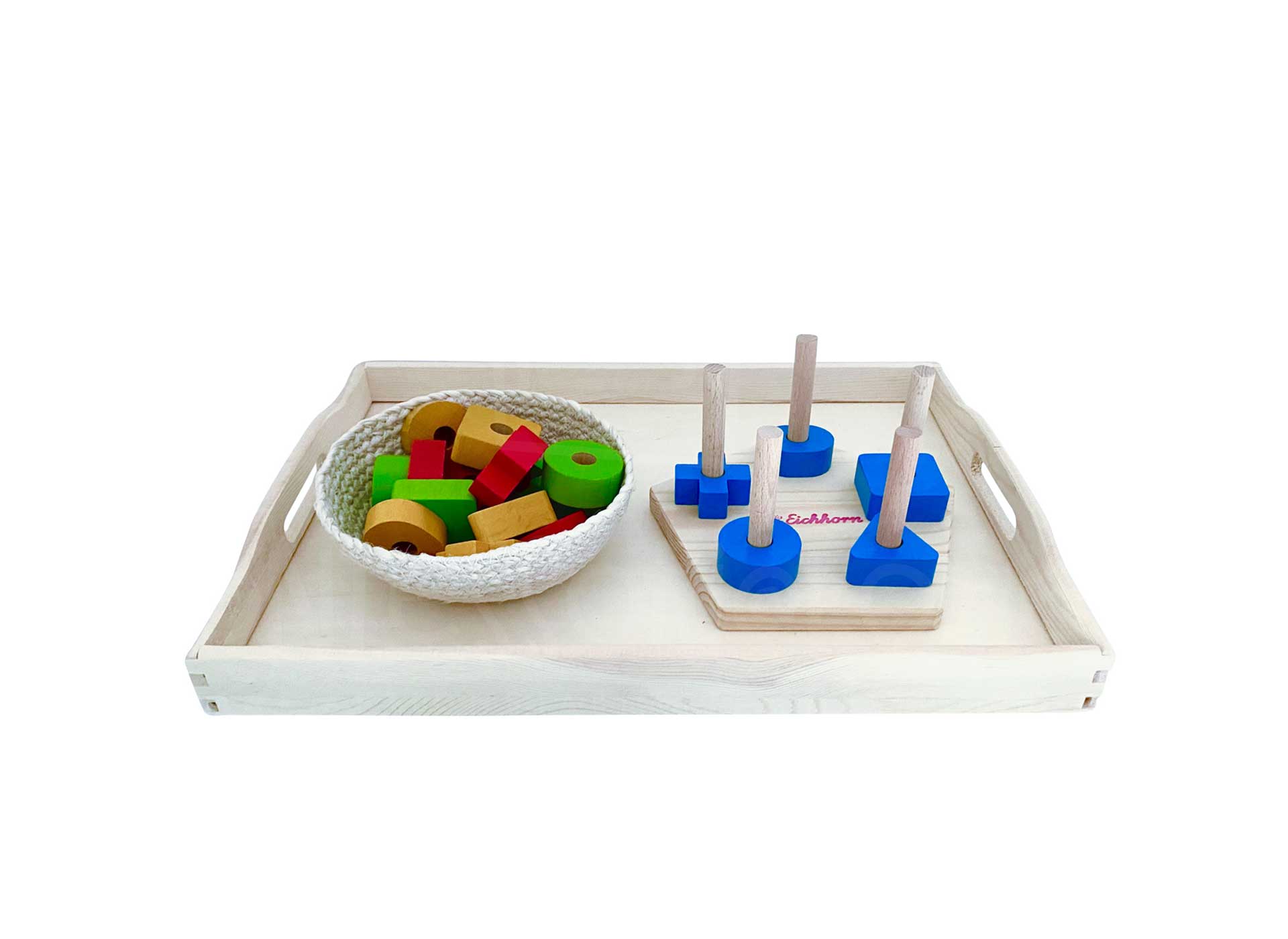
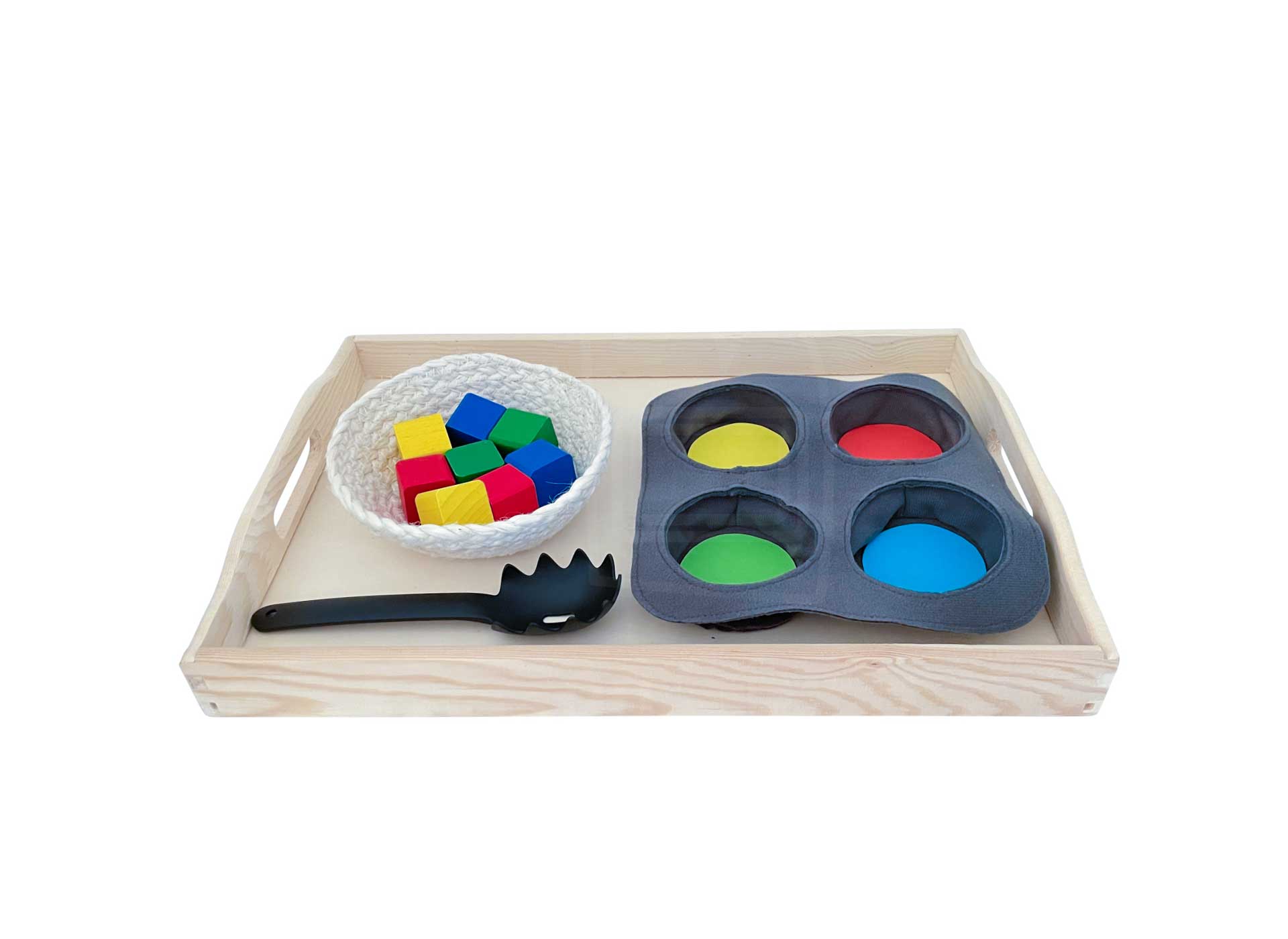
Sorting colors with ladle
Objective: Promote eye-hand coordination and color perception
Material: colorful building blocks*, colorful paper, basket, IKEA children’s muffin tin, children’s ladle*
Preparation: 8 building blocks of the same size, 2 of each color are placed in the basket. Then cut out 4 equally sized round circles from paper and place one circle in each compartment of the muffin tin. The basket is placed on the tray on the left, along with the ladle and the muffin tin on the right.
Execution: The child scoops the building blocks out of the basket with the ladle and into the color-matching compartment of the muffin tin. After all 8 building blocks have been scooped into the muffin tin, they are placed back into the basket or scooped. The scooping process can also be assigned to the “everyday life” task area.
Sort pillows
Objective: Promote color perception and eye-hand coordination
Material: Small pillows*, 2 baskets, giant tweezers*, red paper, scissors
Preparation: A few feel-memo pillows are placed in a basket and this is placed on the tray. With the scissors, a circle is cut out of the red paper and this is placed in the second basket. Then this and the tweezers are also placed on the tray.
Execution: The child sorts out from the left basket the pillows that match the color of the circle cut out, grabs them with the tweezers and puts them in the right basket. Then all the pillows are put back into the left basket and mixed by color.
This material can also be used to promote motor skills.
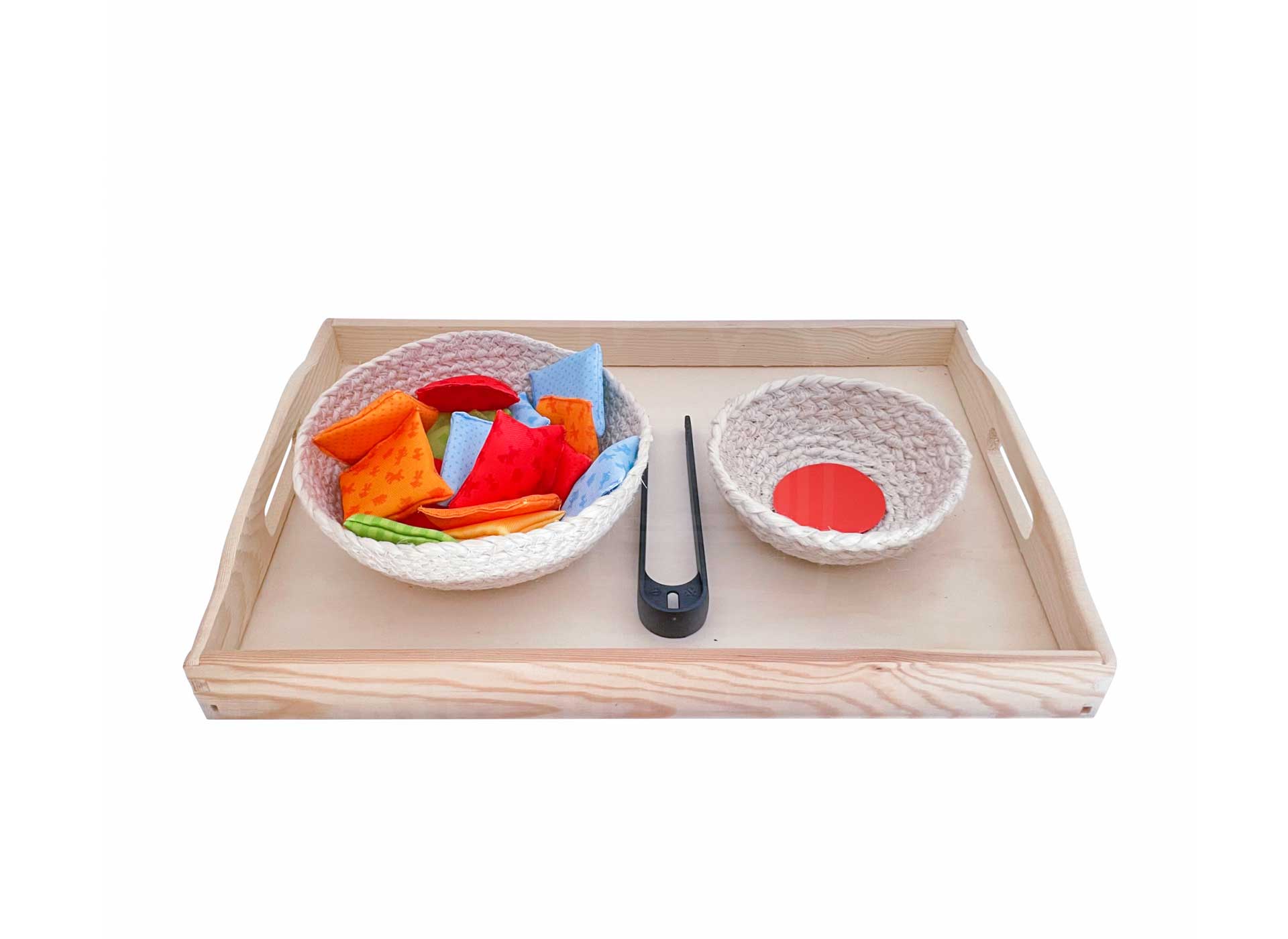
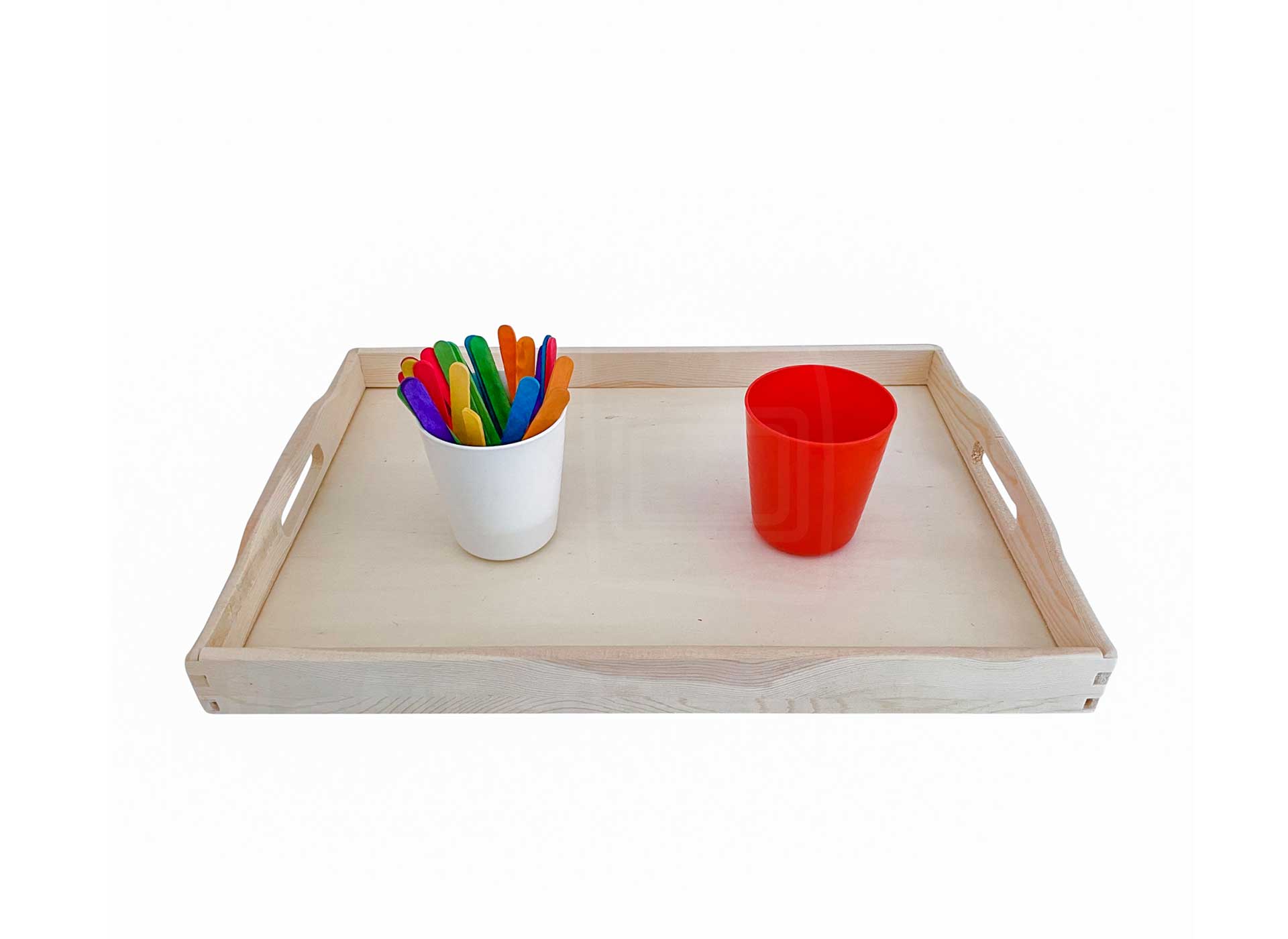
Colorful popsicle stick mix
Objective: promote eye-hand coordination and color perception
Material: colorful popsicle sticks*, white and red plastic cup
Preparation: a handful of colorful wooden popsicle sticks are placed in the white cup and it is placed on the left side of the tray. A colored cup is placed on the right side of the tray, here red.
Execution: The child picks out all the popsicle sticks from the white cup that match the color of the cup on the right side and puts them into the colored cup, here red. When there are no more red popsicle sticks in the white cup and all the popsicle sticks have been found, the red popsicle sticks are put back into the white cup and mixed again.
Sort building blocks
Objective: Promote color perception and eye-hand coordination
Material: Small building blocks*, basket, colorful plastic bowls
Preparation: Building blocks in the colors of the plastic bowls are placed in the basket. This is placed on the tray on the left. The plastic bowls in the different colors are placed to the right.
Execution: The child takes a building block from the basket and sorts it into the right plastic bowl in the matching color. This is repeated until all the building blocks are in the plastic bowls. Then all are put back into the left basket and mixed by color.
This material can also be used to promote motor skills.
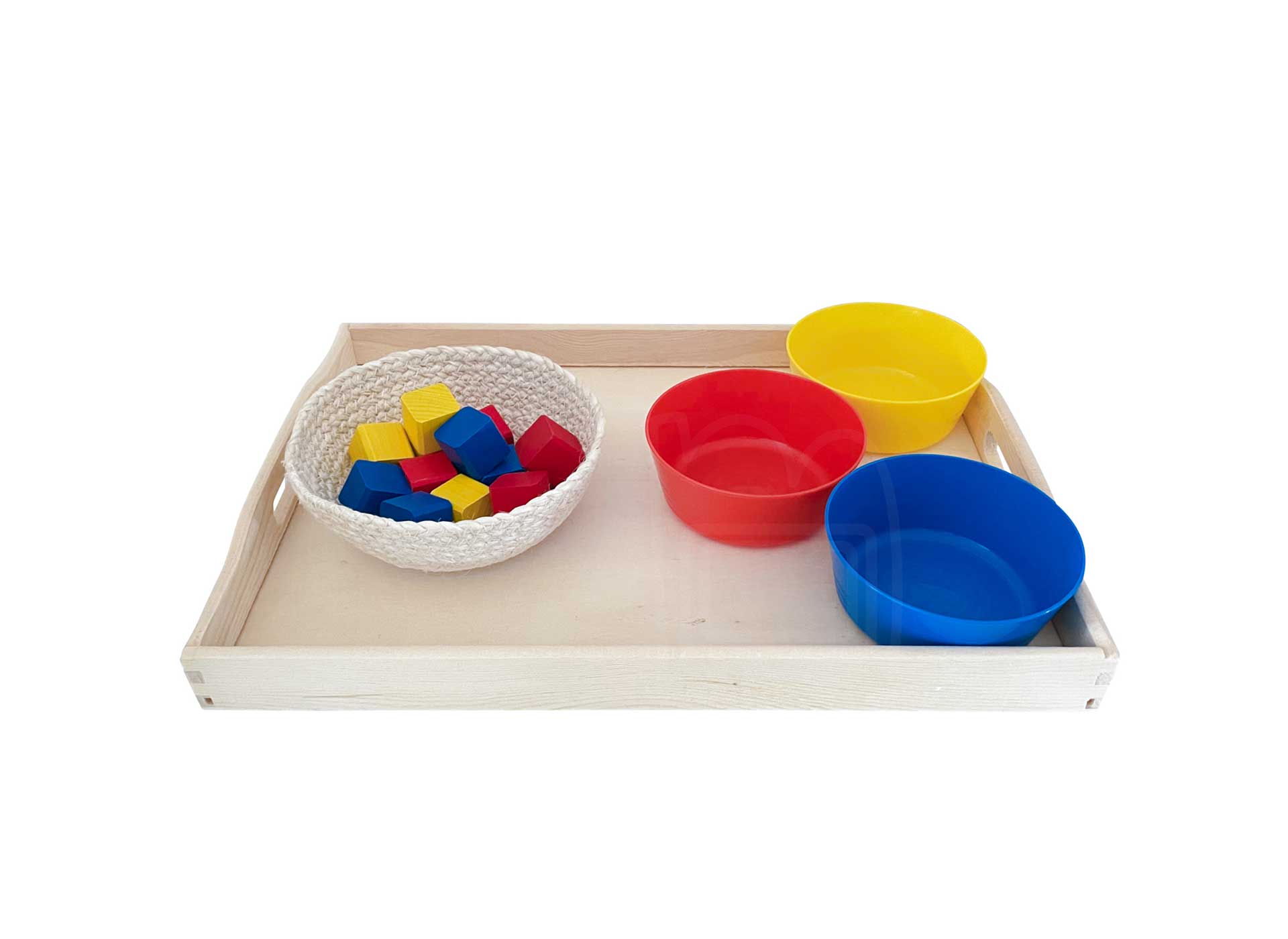
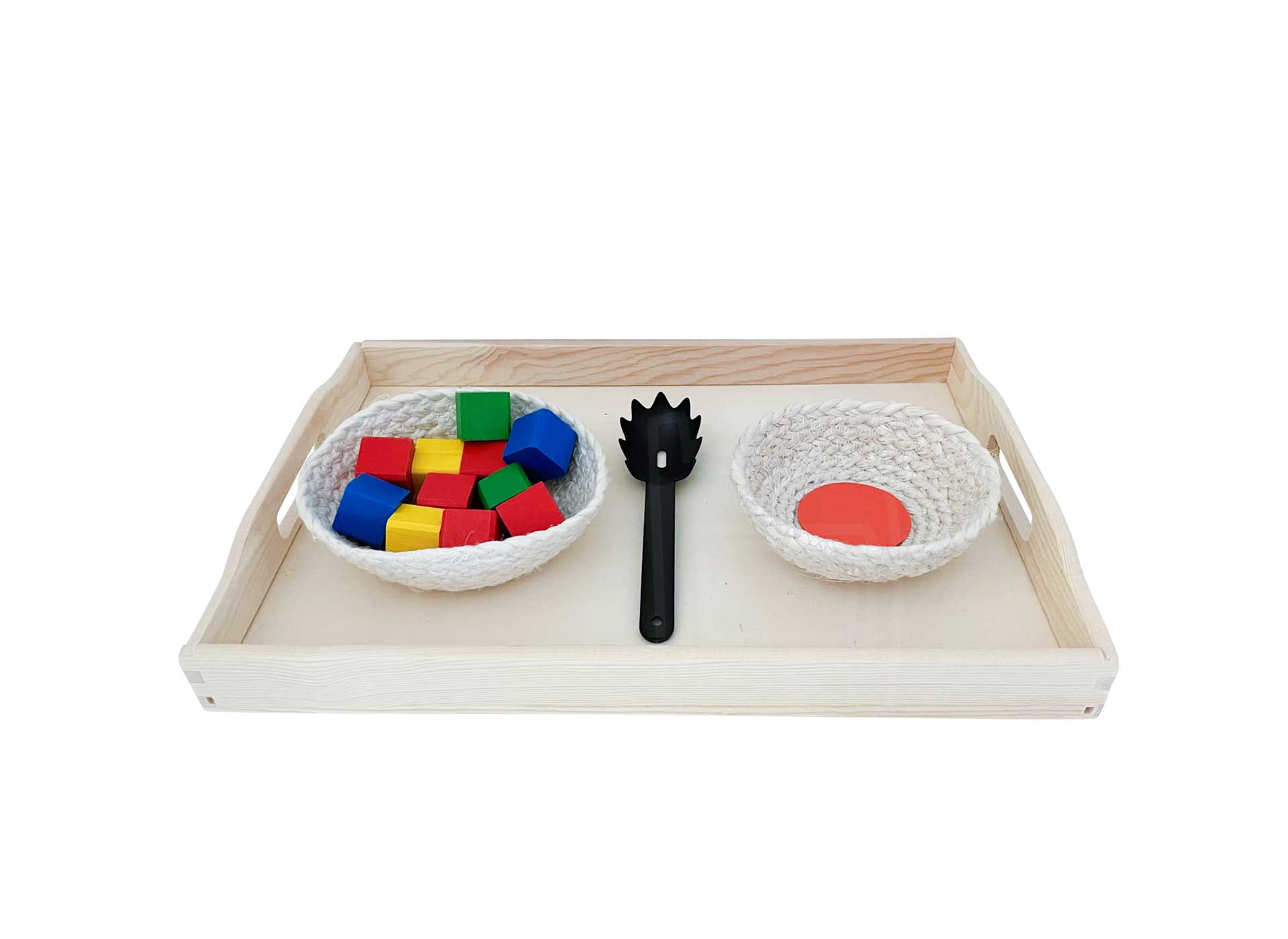
Color scooping
Objective: Promote eye-hand coordination and color perception
Material: colorful building blocks*, colorful paper, 2 baskets, children’s dipper*
Preparation: A few building blocks are placed in a basket. Then, a round circle is cut from a colored paper, which is one of the colors of the building blocks, and placed in the second basket. Now both baskets, the one with the building blocks on the left, are placed on the tray with the ladle in between.
Execution: The child scoops the building blocks, which match the color of the cut circle, with the scoop from the left basket into the right basket until all the matching colored blocks, here red, are in the right basket, then all the blocks are put back into the left basket and mixed. The scooping process can also be assigned to the task area “everyday life”.
Colorful vehicle puzzle
Objective: Promote color perception and eye-hand coordination
Material: Wooden puzzle* (link is not the same, but the puzzle has the same functionality), basket
Preparation: All puzzle pieces are taken out of the wooden frame and placed in the basket. Both are placed on the tray.
Execution: The child takes one puzzle piece after the other out of the basket and puts it on the corresponding place in the wooden frame. Because all puzzle pieces look the same as the corresponding place in the wooden frame, this is a wonderful first puzzle to replay and can therefore already contain more pieces.
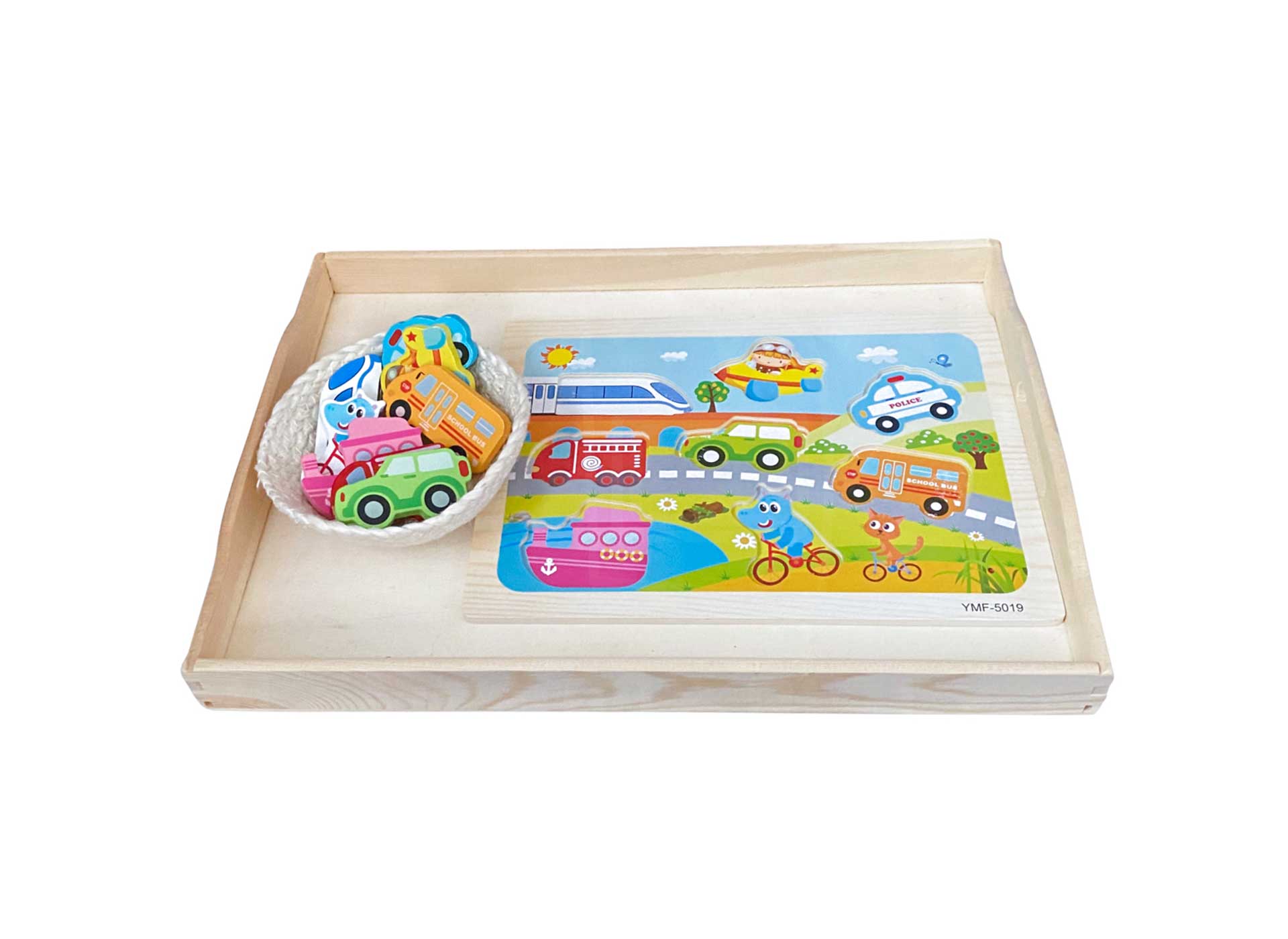
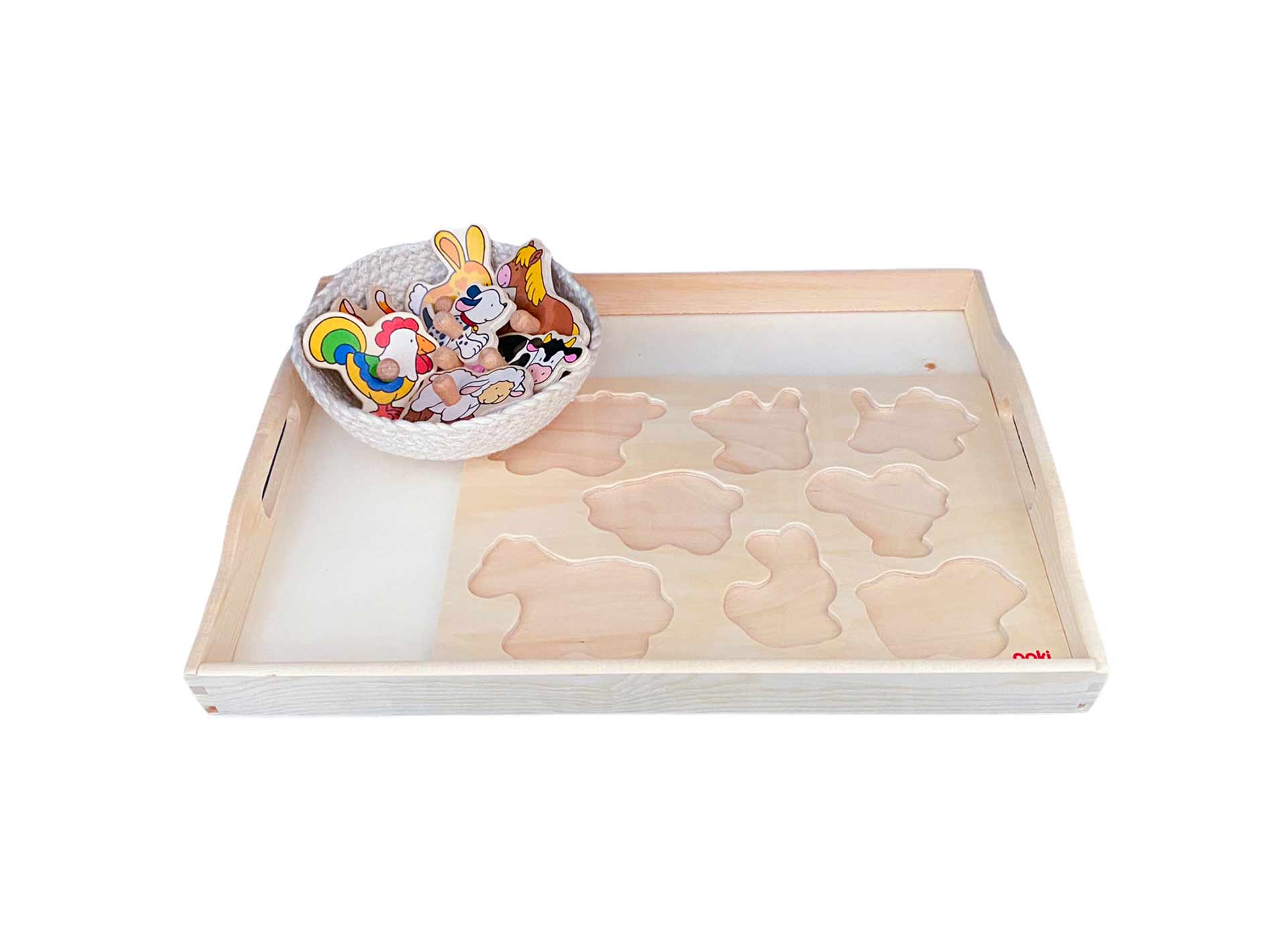
Greifpuzzle Tiere
Ziel: Auge-Hand-Koordination, Pinzettengriff und Formwahrnehmung fördern
Material: Goki animal plug puzzle*, basket
Preparation: All puzzle pieces are placed in the basket and the basket together with the wooden frame is placed on the tray.
Execution: The child takes one puzzle piece after the other and tries to find the right place in the wooden frame.
When the child is finished, all the pieces go back into the basket and everything goes on the tray.
Color puzzle
Objective: Promote color perception, shape perception and eye-hand coordination
Material: Color puzzle* (it’s not exactly the same, because the one we have used is not available on the US market)
Preparation: All puzzle pieces are mixed and placed on a tray. Depending on the level of difficulty, only a few colors can be used at first for smaller children.
Execution: The child looks for the color-matching pieces and puzzles them together. Depending on age and vocabulary, the child can also name the color and the object.
When the child has finished puzzling, all the pieces are taken apart again and mixed.
This tray can also be assigned to the category “Auditory” if the child not only puzzles but also names the objects.
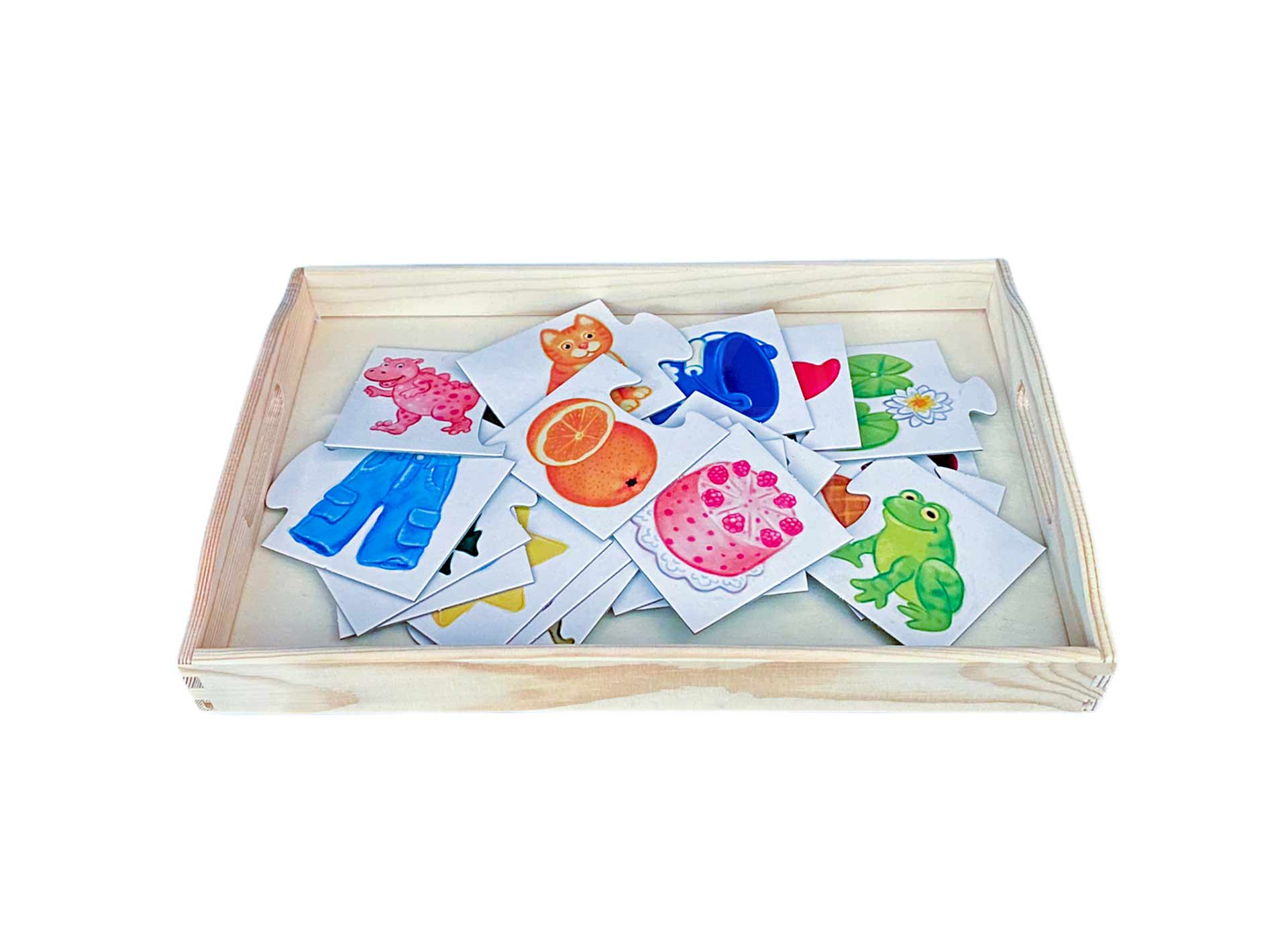
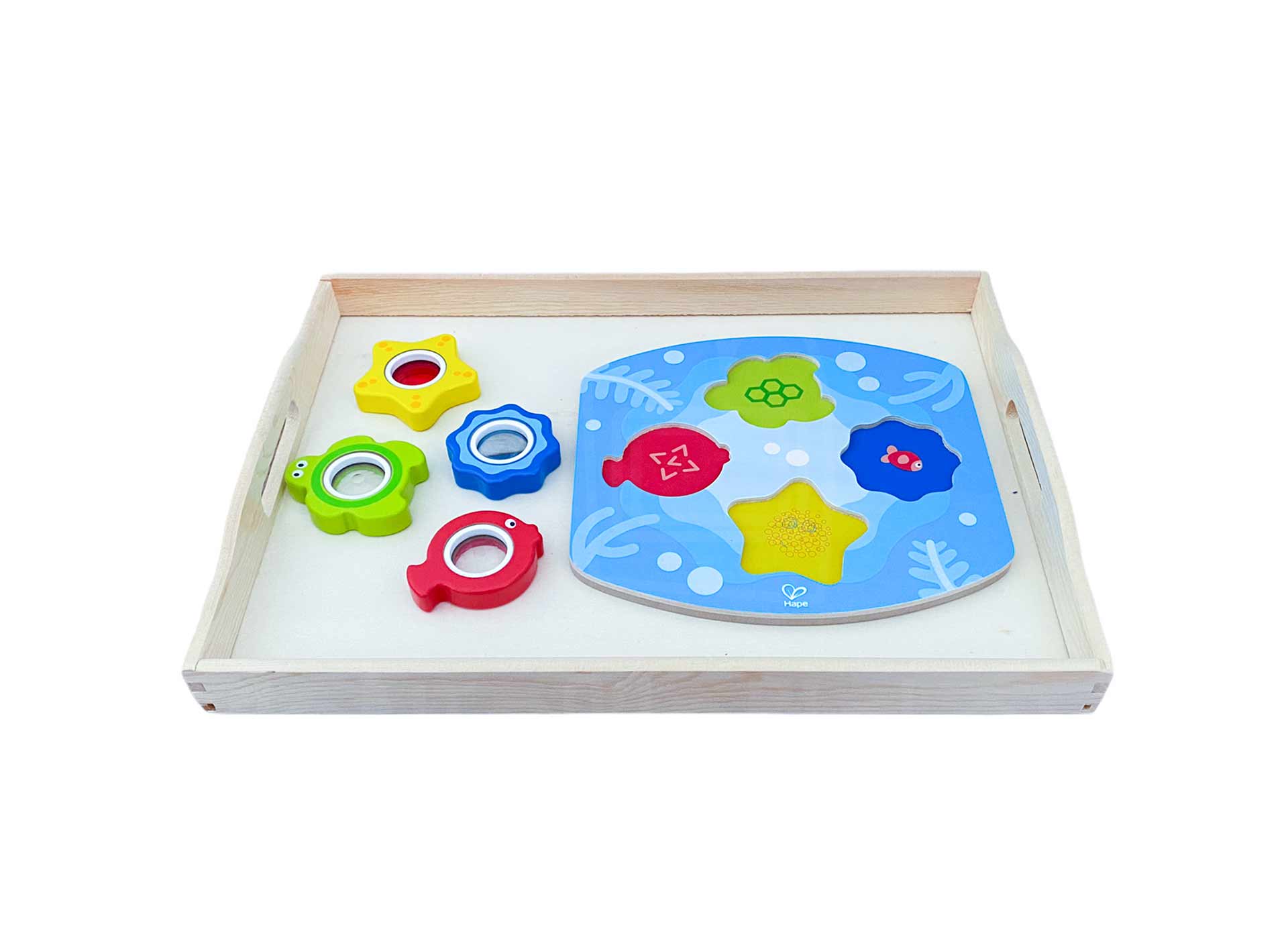
Underwater discovery puzzle
Objective: Promote eye-hand coordination and shape perception
Material: Hape Puzzle*
Preparation: All puzzle pieces are placed on a tray to the left of the wooden frame.
Execution: The child takes one puzzle piece after the other and tries to find the right place in the wooden frame.
When the child is finished, all the pieces go back into the basket and everything goes on the tray.
This puzzle can be solved not only by shapes, but also trains color perception, because the pieces are colored in the same color as the matching place in the frame.
Pair finder
Objective: Promote color perception, shape perception and eye-hand coordination
Material: Shapes & Colors Game*
Preparation: A game board and the 6 matching round game cards are selected from the shapes and colors game and placed together on a tray. The round cards are on the left and the game board is on the right.
Execution: The child takes one round card after the other and places them on the same symbol on the game board on the right.
When all the cards have been correctly matched, they are put back next to the board.
Depending on the child’s linguistic progress, the child can also name the symbols on the cards when he or she puts them down.
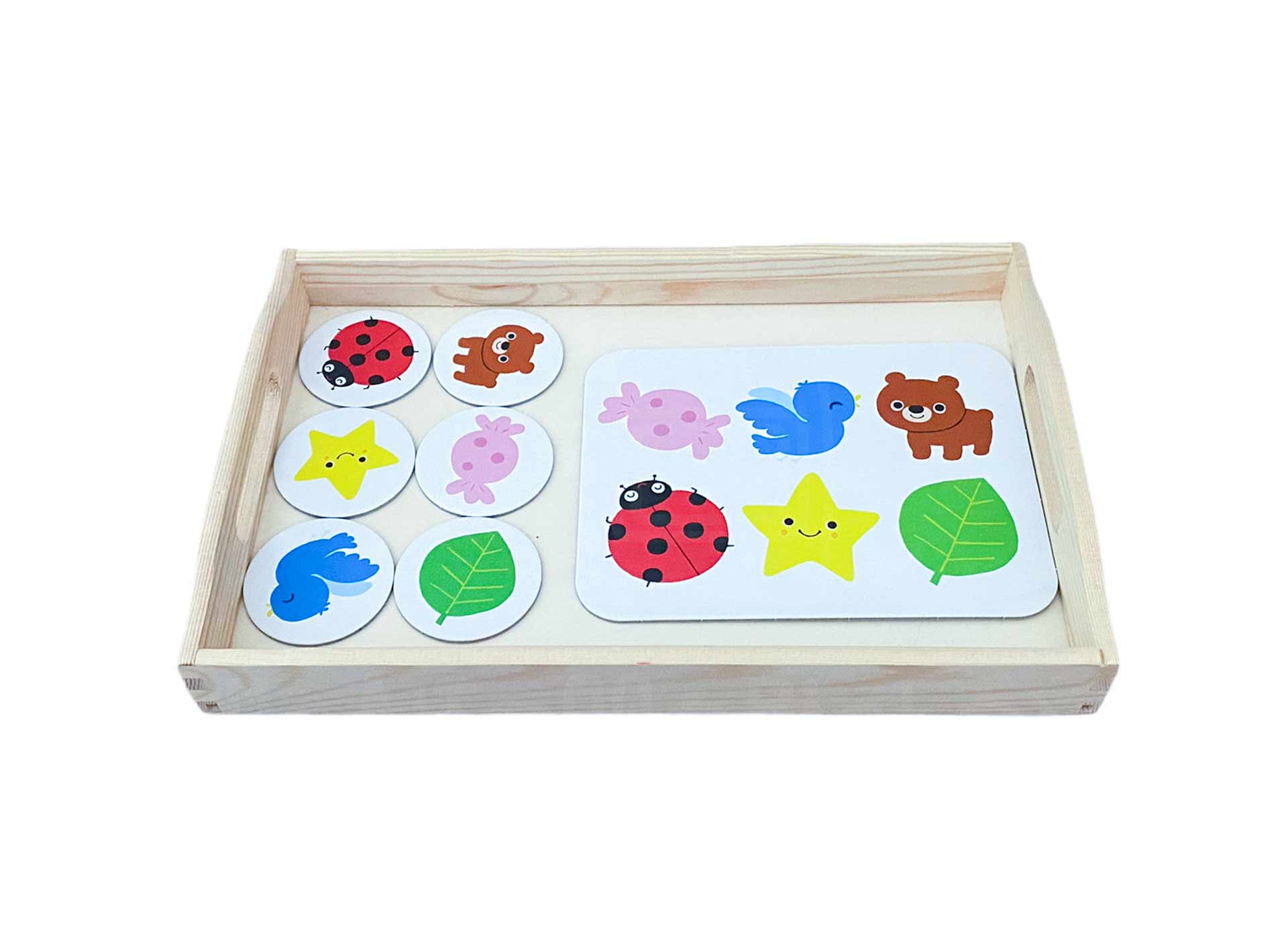
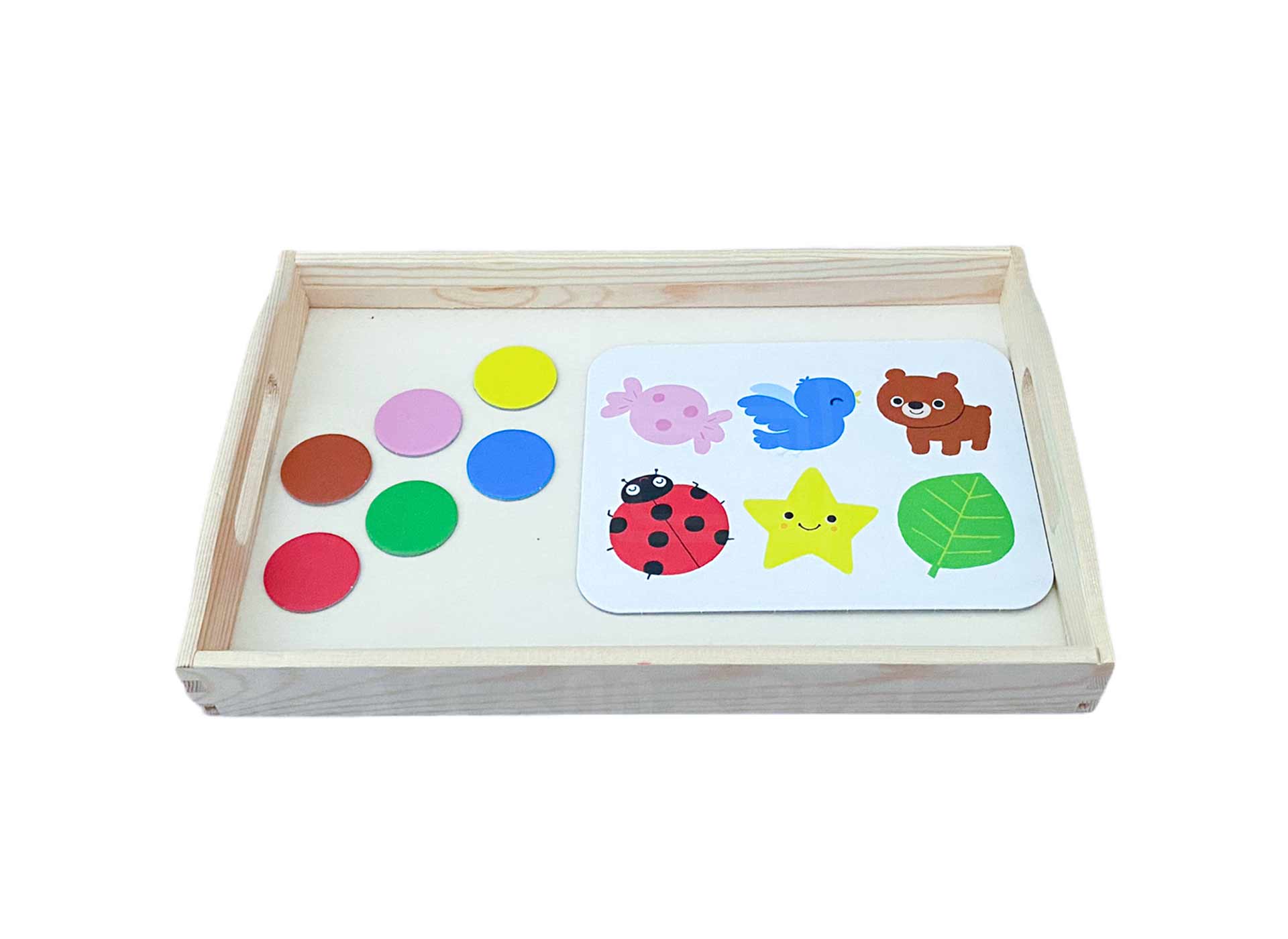
Color comparison
Objective: Promote color perception and eye-hand coordination
Material: Shapes & Colors Game*
Preparation: A game board and the 6 matching round colored game cards are selected from the shapes and colors game and placed together on a tray. The round cards are on the left and the game board is on the right.
Execution: The child takes one round card after the other and places it on the matching colored symbol on the right game board.
When all the cards have been correctly matched, they are put back next to the board.
Depending on the child’s linguistic progress, the child can name the color while matching it.
Sticking game colorful world
Objective: Promote color perception and eye-hand coordination
Material: Shapes & Colors Game*
Preparation: A template card and the matching pieces are selected from the game. These are then placed together on the tray. On the left the stones, on the right the sticking board.
Execution: The child takes the game pieces and puts them into the matching color slots.
When all the pieces have been correctly matched, they are put back next to the game board.
Depending on the child’s linguistic progress, the child can also name the color when placing the stone.
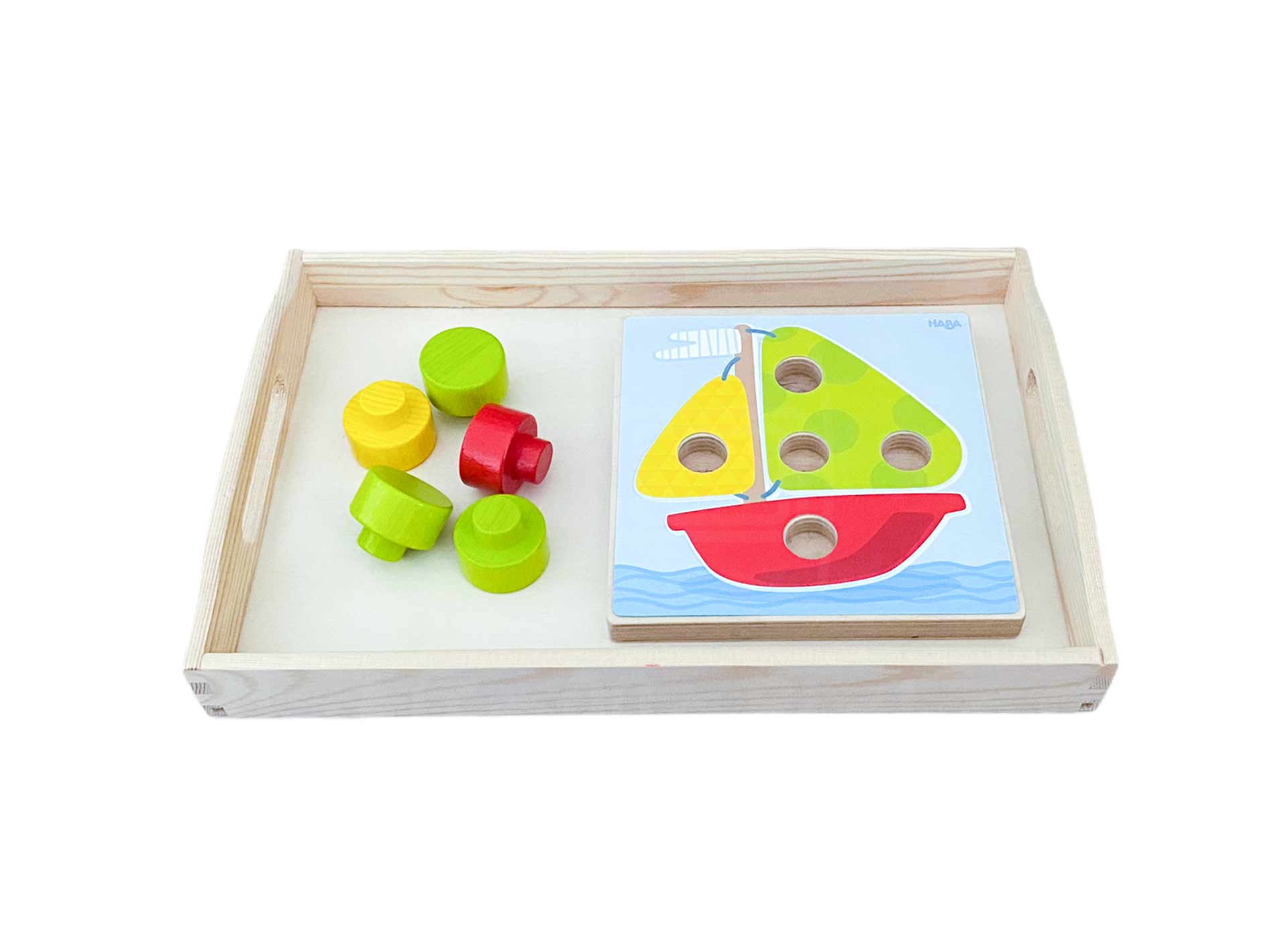
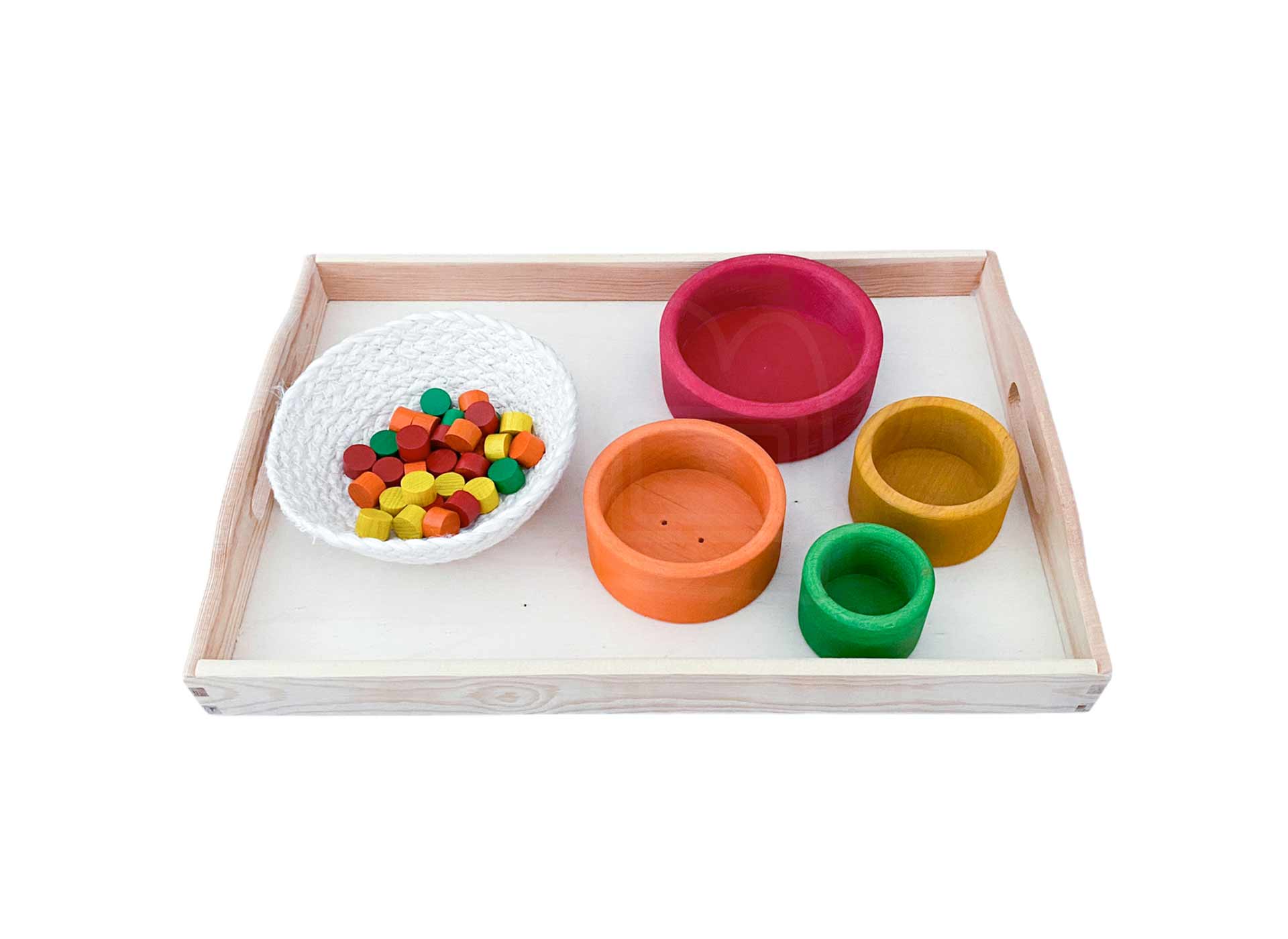
Arrange stones
Objective: Promote color perception and eye-hand coordination
Material: Ravensburger Quips*, Grimm’s set of bowls*, basket
Preparation: The stones in the matching colors to the bowls are selected from the Quips game and placed in a basket. The basket with the stones and the Quips stones are placed together on a tray.
Execution: The child takes the stones from the basket and puts them into the matching colored bowl.
When all the stones have been correctly matched, they are put back into the basket.
Depending on the child’s linguistic progress, the child can also name the color when placing a stone.
Caution: The Quips stones are small parts and can be swallowed. Therefore, this tray should only be handled under adult supervision or by children who do not put small parts in their mouths.
* Links, welche mit einem Sternchen (*) versehen sind, stellen Amazon Partnerlinks dar (Affiliate-Links / Provisionslinks). Wenn du über diese Links etwas kaufst, erhalten wir eine kleine Provision, denn von etwas müssen wir ja auch leben. Dir entstehen dabei aber keinerlei zusätzlichen Kosten.
